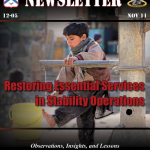L&O operations have historically been understood to consist of LE missions supporting U.S. military commanders and their efforts to police our military personnel, civilians, and family members working and residing on U.S. military posts, camps, and stations. (Posts, camps, and stations refer to any U.S. military installation, base, or other location within the United States and enduring installations, bases, or other locations outside the United States employed to support long-term military commitments and/or serve as power projection platforms.) U.S. Army doctrine has not historically focused on L&O operations outside of LE support to posts, camps, and stations. L&O support to the operational commander and the capabilities inherent within LE organizations have been largely disregarded within Army (and joint) doctrine. Recent conflicts and the nature of the threat within the OE have increased the relevance of L&O operations and LE capabilities in support of Army operations. The applications of L&O operations and the requirements for Army LE personnel to conduct these operations have grown tremendously as nation building and protracted stability operations have demonstrated the need for civil security and civil control as critical lines of effort within the larger effort to transfer authority to a secure and stable HN government.
Read more →

